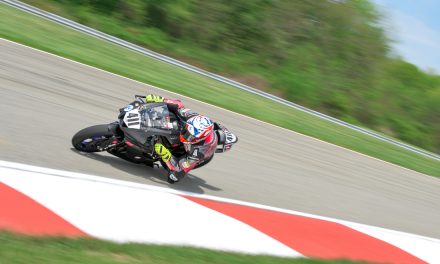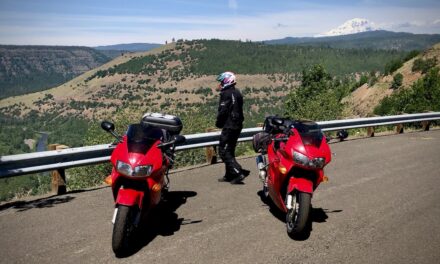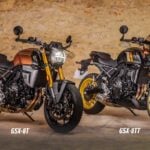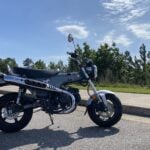Several years ago I purchased the complete box set of the old History Channel series, “Dogfights”. The series retells and recreates in digital animation many of the great air battles of the past century. My favorites are the episodes about the planes, pilots and battles of WWII and Vietnam, and the tactics and technologies they employed in air-to-air combat. Having grown up a proud “Air Force brat“, I’ve always been fascinated with fighter aircraft and the jockeys who have flown them.
It’s intriguing to me, watching the interviews with fighter pilots from the different wars, picking up on their common lingo and language. Being a motorcycle rider, I’ve found many similarities between the phrases and practices of pilots in combat, and the necessary skills a motorcyclist should possess for the street.
1. Target Fixation– If a fighter pilot gets “tunnel vision,” i.e. fixating on a specific target to the exclusion of anything else, he is vulnerable to attack from undetected enemies. Focusing so intently on the engagement in front of him can lead a pilot to become the unwitting and unwilling target of a hostile aircraft behind him. In the same way, when riding a motorcycle, if the rider fixates on an object or situation unfolding in front of him, he can lose awareness of what might be happening more immediately around or behind him, and hence put himself in danger. Solution? Snap out of it. Look beyond the object or obstacle, and negotiate a path through or around.
2. Head on a Swivel– Fighter pilots are trained to not just look around constantly, but move their heads around and up/down, to gain the widest possible field of view. For the motorcyclist, this means he must move his head, not just his eyes, as he scans his environment. Use all of your range of head and eye motion to visually scan. Studies show the average human has around 170 degrees of peripheral vision. Couple that with approximately 90 degrees of side-to-side head rotation, plus the nearly 90 degrees of eye motion side-to-side, and the average person has almost 360 degrees of visual field.
Studies show the average human has about 170 degrees of peripheral vision
*Try this: Look straight ahead, and test your peripheral vision by moving your two index fingers from front/center, to either side. See how far around your fingers are still visible? Now, still looking straight out past your nose, move your head as far to either side as you can. Once you are at your limit, check your peripherals again. Finally, with your head turned as far as you can, move your eyes as far to each side as well. You should be able to see, with peripheral vision, head turn, and eye turn, actually farther than 360 degrees. Amazing! Owls got nothing on us.
3. Eyes Outside the Cockpit– Fighter pilots must constantly remember to scan far out in front of them, and not just rely on their instruments and high-tech equipment. No technology has, nor ever will, take the place of the human eye. As motorcyclists, we must also learn to perceive far out in front, and not just focus on the road immediately in front of us. Experts say we should visually search as far as 12 seconds ahead of us, to give the maximum amount of time to SEE: “Scan, Evaluate, Execute” as the old MSF course taught us.
SEE: Scan, Evaluate, Execute
4. Check Your 6– Pilots must always glance behind them while in dogfight situations, to insure they don’t have someone on their tail, lining up to shoot them down. Many a pilot has been blown from the sky or worse, met their demise, by neglecting to “check their 6”. In the same way, prior to any maneuver, a motorcyclist should check mirrors and glance side-to-side before execution. Be aware of any and all activity around and behind, to insure no one or nothing “takes you out.”
Fighter pilots operate in a complete “look up, look down, look all around” environment, and must constantly practice these skills and others for their very survival. Though we as motorcyclists are not engaging in literal combat, riding a bike can be a dangerous, even deadly, endeavor. Constantly changing road conditions, weather, traffic variables, distracted, aggressive “cagers”- it can feel like a war zone on the streets. So I’ve come to practice these simple tactics every time I take to the streets, borrowed from veteran fighter pilots who have seen and survived air combat. They certainly apply to street riding.
Rob






























Great Advice! I’ve used most of these throughout my riding years and have carried them with me when I am on 4 wheels. I believe motorcyclists, when truly focused, are some of the best drivers/riders on the road.
Thanks Don! And I would agree- great skills for air and street, 2 wheels or 4. I also agree that riders can make the best motorists. Honestly, I think I’m a better rider than driver. Too many distractions in a “cage”, too many gadgets to draw attention away from the road. On a bike, I’m totally dialed in, focused, in the moment. BTW, check out this article as well, if you haven’t yet-
https://roaddirt.tv/mystic-rhythms/
Great article. I feel like there’s something missing, like “anticipate your enemy’s next move.” Example: I’m riding in the left lane, next to a car in the right lane, when I see the distance between the car and a truck ahead of him reducing quickly. I need to anticipate that he’s about to move over, into space that I’m occupying. Thanks again, it was thought-stimulating.
I’d have to agree with you, Marco. That’s an important skill to master as well. Of course, that’s also a great example of “SEE” as in Scan, Evaluate, Execute, something we reference in the article. Anything we can do to survive the “mean streets”, we should incorporate.
Best to you,